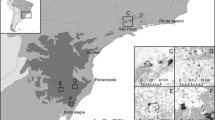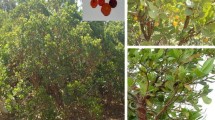Abstract
Stachyurus macrocarpus is a narrowly endemic endangered shrub of which only one population remains on Chichi-jima Island (Ogasawara). We surveyed its population dynamics and reproductive states for 4 years and analyzed the population viability. In a survey of its entire distribution range, a total of 87 S. macrocarpus individuals have been found and 68 individuals have been confirmed in 2007. Thus, the actual population size is estimated to be less than 100 individuals. Environmental conditions and the results of a hand-pollination experiment suggest that low fruit setting in both sexes (female: 4.9–11.2%; hermaphrodite: 0.0%) may be caused by resource limitation. In addition, fruit predation by alien Rattus rattus was observed despite the rare fruit setting. The small effective population size (23.1–24.6 individuals) and hermaphrodite-biased sex ratio (46 hermaphrodites:12 females) would increase the risk of extinction. The habitat of S. macrocarpus was limited to dense scrubland and forest understory, and seedling regeneration was very scarce. During the survey period, 19 individuals (21.8%) were found dead, there were only two seedling recruitments, and the annual population growth rate was 0.979. The lack of occurrence on the south and west slopes and the shortness of shrubs in open spaces suggests that S. macrocarpus suffers stress from both dryness and frequent typhoons. However, S. macrocarpus also exhibited high mortality of shoot in forest understories. These findings suggest that the suitable habitat of S. macrocarpus is likely to be narrow in Ogasawara. While the recent increase of goat grazing has not affected individual mortality, 58.6% of shoots that had been grazed by goats were dead within 2 years. As elasticity analysis had shown that larger individuals make a greater contribution to the population growth rate, repeated goat grazing would impact the S. macrocarpus population in the near future by decreasing the vitality of larger individuals. Emergency measures for protecting the shrub from goat grazing and reinforcing the population through nursery cultivation were proposed.






Similar content being viewed by others
References
Abe T (2006) Threatened pollination systems in native flora of the Ogasawara (Bonin) Islands. Ann Bot 98:317–334
Abe T (2007a) Sex expression and reproductive biology of Stachyurus praecox (Stachyuraceae). Bull For For Prod Res Inst 6:151–156
Abe T (2007b) Predator or disperser? A test of indigenous fruit preference of alien rats (Rattus rattus) on Nishi-jima (Ogasawara Islands). Pacific Conserv Biol 13:213–218
Abe T, Matsunaga M (2007) Germination characteristics of a pioneer shrub, Stachyurus praecox (Stachyuraceae). Bull For For Prod Res Inst 6:145–149
Baillie JEM, Hilton-Taylor C, Stuart SN (2004) 2004 IUCN red list of threatened species: a global species assessment. IUCN Publication Services Unit and The IUCN Species Programme, Cambridge
Brook BW, O’Grady JJ, Chapman AP, Burgman MA, Akçakaya HR, Frankham R (2000) Predictive accuracy of population viability analysis in conservation biology. Nature 404:385–387
Caswell H (2001) Matrix population models, 2nd edn. Sinauer, Sunderland
Coulson T, Mace GM, Hudson E, Possingham H (2001) The use and abuse of population viability analysis. Trends Ecol Evol 16:219–221
Courchamp F, Chapuis JL, Pascal M (2003) Mammal invaders on islands: impact, control and control impact. Biol Rev 78:347–383
Delph LF (1999) Sexual dimorphism in life history. In: Geber MA, Dawson TE, Delph LF (eds) Gender and sexual dimorphism in flowering plants. Springer, Berlin, pp 149–173
Delph LF, Meagher TR (1995) Sexual dimorphism masks life history trade-offs in the dioecious plant Silene latifolia. Ecology 76:775–785
Drayton B, Primack RB (2000) Rates of success in the reintroduction by four methods of several perennial plant species in eastern Massachusetts. Rhodora 102:299–331
Ellstrand NC, Elam DR (1993) Population genetic consequences of small population size: implications for plant conservation. Ann Rev Ecol Syst 24:217–242
Environmental Agency of Japan (2000) Threatened wildlife of Japan–red data book, 2nd edn., vol 8. Vascular plants. Japan Wildlife Research Center, Tokyo (in Japanese)
Falconer DS (1989) Introduction of quantitative genetics. Longman, Harlow
Frankham R (1995) Effective population size/adult population size ratios in wildlife: a review. Genet Res 66:95–107
Frankham R (1996) Relationship of genetic variation to population size in wildlife. Conserv Biol 10:1500–1508
Frankham R, Ballou JD, Briscoe DA (2002) Introduction to conservation genetics. Cambridge University Press, Cambridge
Franklin IR (1980) Evolutionary change in small populations. In: Soulé ME, Wilcox BA (eds) Conservation biology: an evolutionary–ecological perspective. Sinauer, Sunderland, pp 135–150
Gross KL, Soule JD (1981) Differences in biomass allocation to reproductive and vegetative structures of male and female plants of a dioecious, perennial herb, Silene alba (Miller) Krause. Am J Bot 68:801–807
IUCN (1994) IUCN red list categories. IUCN-Species Survival Commission, Gland
Iwatsuki K, Boufford DE, Ohba H (1999) Floral of Japan, Volume IIc Angiospermae, Dicotyledoneae, Archichlamydeae (c). Kodansha Ltd., Tokyo
Kaizuka S (1977) The geology and geography of the Ogasawaras. Ogasawara Kenkyu Nenpo 1:29–34 (in Japanese)
Kasaki H (1991) Endangered plants on Ani-jima Island. Ogasawara Kenkyu Nenpo 15:1–19 (in Japanese)
Kruger LM, Midgley JJ, Cowling RM (1997) Resprouters vs reseeders in South African forest trees: a model based on forest canopy height. Func Ecol 11:101–105
Kwit C, Horvitz CC, Platt WJ (2004) Conserving slow-growing, long-lived tree species: input from the demography of a rare understory conifer, Taxus floridana. Conserv Biol 18:432–443
Lande R (1993) Risks of population extinction from demographic and environmental stochasticity and random catastrophes. Am Nat 142:911–927
Lande R, Barrowclough GF (1987) Effective population size, genetic variation and their use in population management. In: Soulé ME (ed) Viable populations for conservation. Cambridge University Press, New York, pp 87–123
Lavergne S, Thompson JD, Garnier E, Debussche M (2004) The biology and ecology of narrow endemic and widespread plants: a comparative study of trait variation in 20 congeneric pairs. Oikos 107:505–518
Li HL (1943) The genus Stachyurus. Bull Torrey Bot Club 70:615–628
Lonsdale WM (1999) Global patterns of plant invasions and the concept of invisibility. Ecology 80:1522–1536
Loope LL, Hamann O, Stone CP (1988) Comparative conservation biology of oceanic archipelagoes Hawaii and the Galapagos. BioScience 38:272–282
Loope LL, Mueller-Dombois D (1989) Characteristics of invaded islands, with special reference to Hawaii. In: Drake JA, Mooney HA, Di Castri F, Groves RH, Kruger FJ, Rejmánek M, Williamson M (eds) Biological invasions: a global perspective. Wiley, West Sussex, pp 257–280
Menges ES (2000) Population viability analyses in plants: challenges and opportunities. Trends Ecol Evol 15:51–56
Midgley JJ (1996) Why the world’s vegetation is not totally dominated by resprouting plants; because resprouters are shooter than reseeders. Ecography 19:92–95
Nunney L, Campbell KA (1993) Assessing minimum viable population size: demography meets population genetics. Trends Ecol Evol 8:234–239
Nunney L, Elam DR (1994) Estimating the effective population size of conserved populations. Conserv Biol 8:175–184
O’Dowd DJ, Green PT, Lake PS (2003) Invasional ‘meltdown’ on an oceanic island. Ecol Let 6:812–817
Ohi T, Kato H, Murata J (1998) Distribution of endangered plants (Stachyurus macrocarpus, S. macrocarpus var. prunifolius, and Eurya boninensis) in the Ogasawara Islands. Ogasawara Kenkyu Nenpo 22:51–55 (in Japanese)
Ohi T, Murata J (1999) Geographical variations in chloroplast DNA of Stachyurus macrocarpus Koidz. and S. praecox Sieb. et Zucc. (Stachyuraceae). Ogasawara Res 25:1–25
Ohi T, Wakabayashi M, Wu S, Murata J (2003) Phylogeography of Stachyurus praecox (Stachyuraceae) in the Japanese Archipelago based on chloroplast DNA haplotypes. J Jpn Bot 78:1–14
Oka S, Yoshida K, Iwashita H, Iijima Y, Satoh T (2000) Interannual variability of the hydroclimatic environment, based on the water balance at Chichi-jima Island in the Bonin (Ogasawara) Islands. Ogasawara Res 26:15–33
Oostermeijer JGB (2003) Threats to rare plant persistence. In: Brigham CA, Schwartz MW (eds) Population viability in plants: conservation, management and modeling of rare plants. Springer, Berlin, pp 17–58
Sakai AK, Burris TA (1985) Growth in male and female aspen clones: a twenty-five-year longitudinal study. Ecology 66:1921–1927
Sall J, Creighton L, Lehman A (2004) JMP start statistics, 3rd edn. SAS Instutite, Cary
Schemske DW, Husband BC, Ruckelshaus MH, Goodwillie C, Parker IM, Bishop JG (1994) Evaluating approaches to the conservation of rare and endangered plants. Ecology 75:584–606
Schofield EK (1989) Effects of introduced plants and animals on island vegetation: examples from the Galapagos Archipelago. Conserv Biol 3:227–238
Shaw JD, Hovenden MJ, Bergstrom DM (2005) The impact of introduced ship rats (Rattus rattus) on seedling recruitment and distribution of a subantarctic megaherb (Pleurophyllum hookeri). Anim Ecol 30:118–125
Shimizu Y (1991) Vegetation of Ani-jima Is. in the Bonin (Ogasawara) Islands: distribution, composition, structure of dry forests. Komazawa Geography 27:7–130 (in Japanese)
Shimizu Y (1992) Origin of Distylium dry forest and occurrence of endangered species in the Bonin Islands. Pacific Sci 46:179–196
Shimizu Y (1999) A 21-year population dynamics in a dry forest at Chichijima in the Bonin Islands. Jpn J Conserv Ecol 4:175–197 (in Japanese)
Shimizu Y (2003a) The nature of Ogasawara and its conservation. Glob Environ Res 7:3–14
Shimizu Y (2003b) Typhoon damage to vegetation on the Ogasawara Islands–the case of Typhoon No. 9 (July 2002). Komazawa Geography 39:1–15 (in Japanese)
Shimizu Y (2005) A vegetative change during a 20-year period following two continuous disturbances (mass-dieback of pine trees and typhoon damage) in the Pinus-Schima secondary forest on Chichijima in the Ogasawara (Bonin) Islands: which won, advanced saplings or new seedlings? Ecol Res 20:708–725
Shimizu Y, Tabata H (1991) Forest structures, composition, and distribution on a Pacific island, with reference to ecological release and speciation. Pacific Sci 45:28–49
Simberloff D (1995) Why do introduced species appear to devastate islands more than mainland areas? Pacific Sci 49:87–97
Smith JLD, McDougal CW (1991) The contribution of variance in lifetime reproduction to effective population size in tigers. Conserv Biol 5:484–490
Sokal RR, Rohlf FJ (1995) Biometry, 3rd edn. Freeman, New York
Soulé ME (1980) Thresholds for survival: maintaining fitness and evolutionary potential. In: Soulé ME, Wilcox BA (eds) Conservation biology: an evolutionary-ecological perspective. Sinauer, Sunderland, pp 151–169
Stone CP, Cuddihy LW, Tunison JT (1992) Responses of Hawaiian ecosystems to removal of feral pigs and goats. In: Stone CP, Smith CW, Tunison JT (eds) Alien plant invasions in native ecosystems of Hawaii: management and research. University of Hawaii Press, Honolulu, pp 666–704
Sutherland WJ Pullin AS, Dolman PM, Knight TM (2004) The need for evidence-based conservation. Trends Ecol Evol 19:305–308
Toyoda T (2003) Flora of Bonin Islands. Aboc-sha, Kamakura (in Japanese)
Yamashita N, Tanaka N, Hoshi Y, Kushima H, Kamo K (2003) Seed and seedling demography of invasive and native trees of subtropical Pacific islands. J Veg Sci 14:15–24
Yoshida K, Iwashita H, Iijima Y, Oka S (2006) Long-term change in the hydroclimatic environment during the 20th century on Chichi-jima in the Ogasawara (Bonin) Islands. Geograph Rev Jpn 79:516–526 (in Japanese)
Acknowledgments
The authors would like to thank Mr. Takaya Yasui and Ms. Midori Yokoya (Ogasawara Wildlife Research Society) for their field assistance. This study was partly supported by funding from the Ministry of the Environment (Global Environment Research Fund F-051).
Author information
Authors and Affiliations
Corresponding author
Rights and permissions
About this article
Cite this article
Abe, T., Wada, K. & Nakagoshi, N. Extinction threats of a narrowly endemic shrub, Stachyurus macrocarpus (Stachyuraceae) in the Ogasawara Islands. Plant Ecol 198, 169–183 (2008). https://doi.org/10.1007/s11258-007-9393-7
Received:
Accepted:
Published:
Issue Date:
DOI: https://doi.org/10.1007/s11258-007-9393-7




